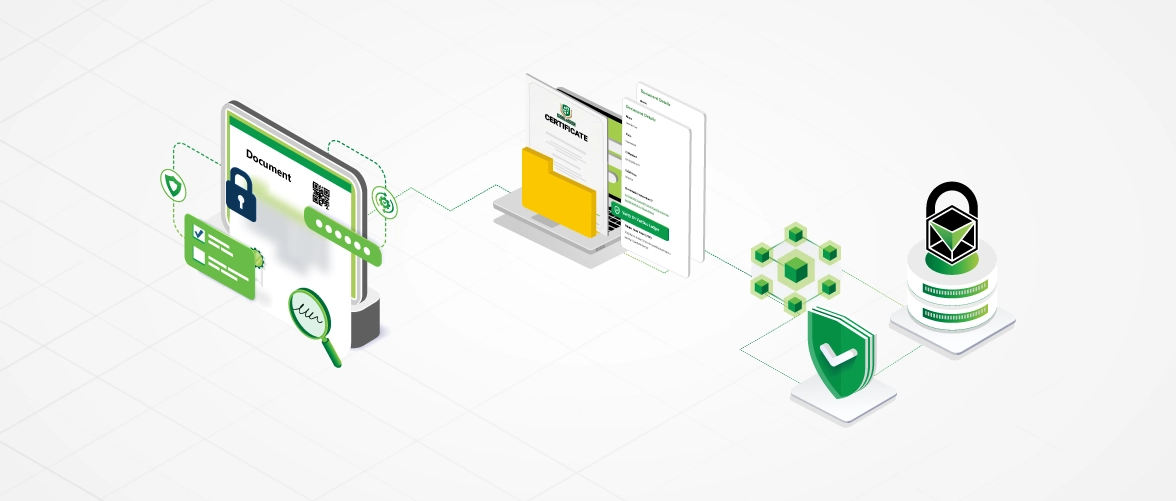Ways To Easily Identify Fake Certificates
06 Oct 2023

Recruiters and universities are increasingly encountering untrustworthy candidates with fake certificates due to the rise of diploma mills and fake certificates. It is very difficult and time taking to identify fake certificates unless it comes with an institute's hologram or blockchain-integrated QR code.
Fake certificates can cause institutions significant financial, time, and reputational damage, so many have taken strong precautionary measures to limit the damage they can cause. It is important to make sure that someone deserving of a job position or student enrollment is not taken by a fraudster.
It can be difficult, however, to recognize fake certificates. Detecting fake certificates can be done in five ways.
Inspecting the Design and components
Let's start with the most obvious measure: Inspecting the Design
As simple as it may seem, this might be your key to identifying the fake certificate from the genuine one. You need to pay extra attention and check the following:
If it has any verification code
If it's embossed
If it has a branded seal
If there's a hologram watermark (can be visible in the light)
If it has a Written Signature
Do not contain spelling mistakes ( Not Printed)
Another giveaway is using outdated typographical fonts, such as ornate or Gothic Typeface. Many fraudsters use it as a technic to make the certificate appears more academic and sophisticated. Still, you know now that it is nothing but an outdated scam.
Lastly, to be more cautious, check the certificate's symbol on the university website. If you're still unsure, you can ask the candidate to bring the original certificate instead of the photocopy. That will make it easier for you to pinpoint the matters mentioned earlier.
Pay attention to the language
You can pick up many warning signs from thoroughly analyzing the language of the certificates. ( Inspected Thoroughly)
For instance, Latin terminology should be a warning as it is rarely used nowadays. Certain expressions are used depending on the country. In The US, for example, the phrase 'cum laude' is widely used in certificates. In contrast, the United Kingdom institutions use mostly 'with honours' Instead. For southeast Asia, the use of "Distinction" is more common.
Refrain from being suspicious only of certificates with weak language. Beware of those tries too hard to sound refined and intellectual as well.
Double-check the University location
Fake university websites usually provide fabricated contact information or use the wrong properties, sometimes even suspicious Domaine links.
An effective way to identify fake degrees via location or Domaine is to:
1) Notice inconsistencies or insufficiencies in the address
2) Obtain confirmation of the University's address
3) Use Google or another mapping platform to locate the exact address provided and see if it's a bogus university, as sometimes the certificates
4) Check the suffix used by the universities in that specific country. For example, in Malaysia, most universities use ".edu.my" at the end of their Domaine, which is carefully restricted.
5) Trust your guts if you doubt the university website address. It probably isn't.
The good news is that many government bodies are making Domaine name providers work to shut down such sites that impressions an established university.
Contacting the source
As the forgery techniques are becoming more advanced, identifying fake certificates is becoming more challenging. It is, therefore, critical to contact the institutions that supposedly issued these certificates.
This method is verification, although old-school, is the most effective way and is recommended when in doubt about a candidate.
Trust the professionals
Many individuals are reluctant to go through this verification process themselves as it is time-consuming and tiring, especially if it involves contacting several institutions and intermediaries. Not to mention the struggles if your certificates are undertaken overseas. That is when a professional solution to verify qualifications is the most effective option.
So How can Universities make their Certificates forgery-proof and easily verified by third parties?
Universities can stop this fake certificate phenomenon by implementing an effective certificate management and verification system, VeriDoc Certificates. It is one of the solutions available; it's an all-in-one certification management solution that simplifies the entire process of certificate issuance and verification.
How? VeriDoc Certificates uses blockchain, a technology that renders your certificates impossible to counterfeit. Our solution gives each of your credentials a unique QR code that anyone can scan to verify the authenticity of the certificates in seconds.
Want to find out more about VeriDoc Certificates? Check out our website.